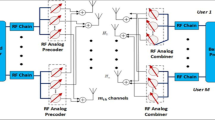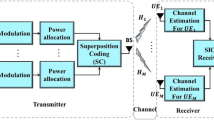Abstract
Millimetre wave communication and massive MIMO are eminent candidates, to meet the requirements in a 5G network. The Combination of these techniques will impart an innovative and efficient transceiver signal processing techniques and radio resource management. The main idea of this paper is to propose a joint framework for user scheduling and hybrid precoder using Machine Learning (ML) for downlink Multi-User Multiple Input and Multiple Output systems (MU-MIMO) to enhance the sum rate. The downlink Multi-User MIMO (MU-MIMO) system model has been implemented in the Keysight’s Electronic System Level (ESL) SystemVue software to generate a channel matrix. Using the simulated channel matrix, correlation among the users were calculated which represents the realistic 5G channel response. A joint framework has been implemented with the Correlation factor-based user scheduling and cross entropy-based hybrid precoder (JUSHP) to maximize the achievable sum rate. The paper also proposes a weight assigned Cross- Entropy based hybrid precoder (JUSWHP) for further improvement in achievable sum rate. In both the framework machine learning algorithm has been applied to choose the best precoder for users in the MU-MIMO system. The simulation results authenticate that the JUSWHP framework achieves better performance with respect to achievable Sum Rate when compared to the other techniques.



Similar content being viewed by others
References
Imran Zoha A, Abu A (2014) Challenges in 5G: how to empower SON with big data for enabling 5G. IEEE Netw 28:27–33. https://doi.org/10.1109/MNET.2014.6963801
Busari SA, Huq KMS, Mumtaz S, Dai L, Rodriguez J (2018) Millimetre-wave massive MIMO communication for future wireless systems. A Surv IEEE Commun Surv Tuts 20:836–869
Niu Y, Li Y, Jin D, Su L, Vasilakos AV (2015) A survey of millimeter wave communication for 5G: opportunities and challenges. Wirel Netw 21:2657–2676
Lu L, Li GY, Swindlehurst AL, Ashikhmin A, Zhang R (2014) An overview of massive mimo: benefits and challenges. IEEE J Sel Topics Sig Process 8:742–758. https://doi.org/10.1109/JSTSP.2014.2317671
Ghosh A et al (2014) Millimeter-wave enhanced local area systems: a high data-rate approach for future wireless networks. IEEE J Sel Areas Commun 32:1152–1163
Health RW, Gonzalez-Prelcic N, Rangan S, Roh W, Sayeed A (2016) An overview of signal processing techniques for millimeter wave MIMO systems. IEEE J Sel Top Sig Process 10:436–453
Ayach OE, Rajagopal S, Abu-Surra S, Pi Z, Heath RW (2014) Spatially sparse precoding in millimeter wave MIMO systems. IEEE Trans Wirel Commun 13:1499–1513
Gao X, Dai L, Han S, I C-L, Heath RW (2016) Energy-efficient hybrid analog and digital precoding for mm wave MIMO systems with large antenna arrays. IEEE J Sel Areas Commun 34:998–1009
Zhao L, Ng DWK, Yuan J (2017) Multi-user precoding and channel estimation for hybrid millimeter wave systems. IEEE J Sel Areas Commun 35:1576–1590
Li A, Masouros C (2017) Hybrid analog-digital millimeter-wave MU-MIMO transmission with virtual path selection. IEEE Commun Lett 21:438–441
Xu H, Yu J, Zhu S (2019) Ping-pong optimization of user selection and beam allocation for millimeter wave communications. IEEE Access 7:1178–1189. https://doi.org/10.1109/ACCESS.2019.2941261
Almradi Ahmed, Matthaiou Michail, Fusco Vincent F (2020) Hybrid precoding for massive MIMO with low rank channels: a two-stage user scheduling approach. IEEE Trans Commun 68:4816–4832
Olyaee M, Eslami M, Haghighat J (2017) An energy-efficient joint antenna and user selection algorithm for multi-user massive MIMO downlink. IET Commun 12:255–260
Benmimoune M, Driouch E, Ajib W, Massicotte D (2015) Joint transmit antenna selection and user scheduling for massive MIMO systems. In: IEEE Wireless Communications and Networking Conference, New Orleans, LA, USA. 381–386
Zhang C, Huang Y, Jing Y, Jin S, Yang L (2017) Sum-rate analysis for massive MIMO downlink with joint statistical beamforming and user scheduling. IEEE Trans Wirel Commun 16:2181–2194
Guo R, Cai MZQSBCY, Hanzo L (2018) Joint design of beam selection and precoding matrices for mm wave MU-MIMO systems relying on lens antenna arrays. IEEE J Sel Topics Sig Process 12:313–325
Bandi A, Chatzinotas S, Ottersten B et al (2019) A joint solution for scheduling and precoding in multiuser miso downlink channels. IEEE Trans Wirel Commun 19:475–490
Chen Xiang, Gong Feng-Kui, Zhang Hang, Li Guo (2019) Pricing user scheduling and precoding in relay-assisted massive MIMO systems. IET Commun 13:545–552
Rubinstein RY, Kroese DP (2004) The cross-entropy method: a unified approach to combinatorial optimization. Monte-Carlo simulation and machine learning. Springer, New York
Cumali I, Ozbek B, Pyattaev A (2020) Beam and user selection technique in millimeter wave communications. In: IEEE 91st Vehicular Technology Conference (VTC2020-Spring) 2020. https://doi.org/10.1109/VTC2020-Spring48590.2020.9128737
Acknowledgements
This research work is supported by the All India Council for Technical Education (AICTE), New Delhi, India, under RPS-NDF (Grant No: 8-3/RIFD/RPS-NDF/Policy-1/2018-2019).
Author information
Authors and Affiliations
Corresponding author
Ethics declarations
Conflict of interest
The authors declare no conflict of interest.
Rights and permissions
About this article
Cite this article
Rajarajeswarie, B., Sandanalakshmi, R. Machine learning based hybrid precoder with user scheduling technique for maximizing sum rate in downlink MU-MIMO system. Int. j. inf. tecnol. 14, 2399–2405 (2022). https://doi.org/10.1007/s41870-022-00902-3
Received:
Accepted:
Published:
Issue Date:
DOI: https://doi.org/10.1007/s41870-022-00902-3




